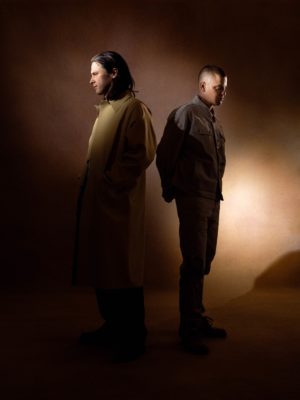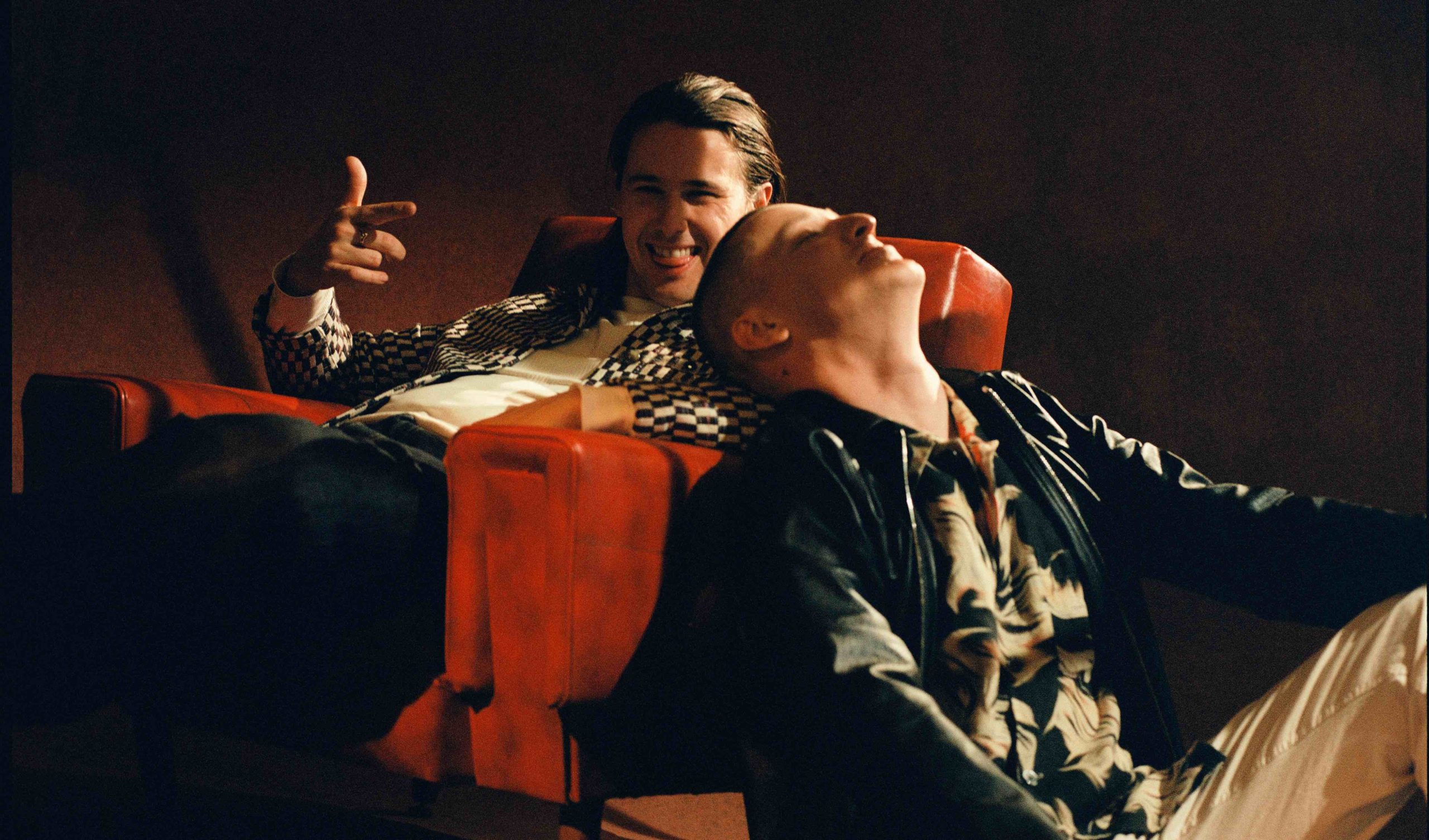Jungle is seeking revenge on the last year and a half of staying stationary. The British electronic-soul duo of Josh Lloyd-Watson and Tom McFarland is hitting the global highway at the start of September. In North America, they’re playing venues that are 3,000-plus in capacity. In the major cities, they’re playing multiple nights in venues that are twice that in size, many of them already sold out. After two critically acclaimed and commercially successful albums, Jungle and For Ever, on the standard-bearing XL Recordings, their third album, Loving in Stereo, is self-released by choice.
With all of Jungle’s accomplishments and the resulting creative control and financial opportunity that comes with that, Lloyd-Watson’s attitude can best be described as nonchalant. A few weeks ahead of Loving in Stereo’s release, he’s on vacation in Marrakesh, Morocco. Silhouetted against the tall and thin palm trees that dot that city, he sports an oversized T-shirt with “London” emblazoned across the chest when we meet over Zoom. “I really like place names,” he says by way of explanation, and lists a few more city T-shirts he has, including Marrakesh, shredding any patriotic significance his attire might be conveying.
Lloyd-Watson does this a lot: giving one impression, then demolishing it instantly with a casual, throwaway explanation. In contrast to their earlier homegrown albums, Loving in Stereo was recorded at Paul Epworth’s The Church Studios with strings and group vocals, as well as features from Bas and Priya Ragu. This all points to Jungle leveling up, but when Lloyd-Watson explains the trajectory of the three albums, Loving in Stereo’s funky, lighthearted, and danceable nature is, in fact, a return to their original sound.
“When we played our midtempo and slow songs live, they were bombing. People were there for the upbeat, fun feeling of Jungle and we re-found that.”
“The first album is two guys in a bedroom making music to hang out to,” he says. “It’s very DIY. There’s a naivete to it. The second album, you want to be taken seriously and do the opposite. We wanted to make records that make people cry. We were waiting for real emotion in our lives to make that happen. Our breakups dictate the story of that album, but when you go through a breakup, you don’t realize you don’t know who you are. You get stripped of your identity and you need to rebuild it. The second record is like we painted a picture and painted over the top again. This third record is the opposite of that, with all the layers stripped back. When we played our midtempo and slow songs live, they were bombing. People were there for the upbeat, fun feeling of Jungle and we re-found that.”
It’s a long way to go and come back over the course of three albums since the emergence of Jungle in 2013, which comes years after the start of Lloyd-Watson’s and McFarland’s friendship at 10 years old. They started producing music while they were still in school—after two singles on the label Chess Club, they were signed to XL Recordings. Their self-titled came like a tsunami in 2014, smashing the Top 10 in the U.K. and snagging a Mercury Prize nomination. Their live shows expanded from the two of them fiddling with gear to seven on-stage members. Jungle became a huge draw, growing stronger with their sophomore album. With every single, they have accompanying videos that progressed from iPhone-captured, Instagram-Story-type footage to increasingly more defined choreographed vignettes.

For Loving in Stereo, Jungle have taken full control of their decisions by independently releasing the album on their own Caiola Records after shrugging off the benefits of XL so the ceiling could be lifted on what they can and can’t do, to paraphrase Lloyd-Watson. One of the major decisions Jungle made in their new, unrestricted state is commission videos for all 14 songs on Loving in Stereo. The videos are shot in the same location, an abandoned fort in the Dover countryside, using the same cast of dancers who all morph into different characters in each clip with a not-so-simple change of clothes, hair, makeup, and choreography. The location, with its peeling walls and exposed electrical ducts, lends itself to every script, changing personalities with each video. Yet there’s a similar light quality and filming style that connects the stories of the videos together, each of which puts the focus on a different selection of dancers. The connection to each character is strengthened with every video released, as the viewer recognizes and starts looking for particular faces.
“If there is a concept it’s to get a bunch of amazingly inspirational people who know each other and have a bond and let them express themselves to your music,” says Lloyd-Watson. “It’s based around the fact that they’re in a bit of a lockdown, and that we’re all trapped in our own heads a lot of the time. It’s almost like the videos are a projection of what they want to be, or what they think they are in real life. Some people might find it really cheesy, but it takes us back to the most basic way of expressing yourself. We did it in single takes to capture the moment as it is, not like when you see a skateboard trick and there’s a cut in it and you can tell it’s not real. We like the imperfections. It gives you this realness value.”
“More than ever we’ve trusted our instincts with the music. That’s the most important thing. You don’t want to second guess yourself for some fan base that you’ve imagined you have, wondering what those people you’ve never met want to hear.”
Dance has been a throughline in the majority of Jungle’s videos with unexpected characters and inventive settings. But it’s never stood on its own as the sole means of storytelling the way it is in the videos for Loving in Stereo—which come with accompanying tutorials on how to execute those dances yourself, courtesy of Jungle’s choreographers. These videos are the embodiment of Jungle realizing their artistic vision, an extension of what they’ve also achieved with the album, which brings their myriad influences together in a fresh combination that has shades of everything from The Beatles, Beach Boys, Pink Floyd, and Marvin Gaye of their younger years to The Strokes, Red Hot Chili Peppers, and Rage Against the Machine, which they got into later, and even more recently J Dilla, DJ Shadow, and RJD2.
“More than ever we’ve trusted our instincts with the music,” says Lloyd-Watson. “That’s the most important thing. You don’t want to second guess yourself for some fan base that you’ve imagined you have, wondering what those people you’ve never met want to hear. You’re going to make something that’s completely overthought. Ultimately, we’re doing this for ourselves. We have to live with it. If you rub people the wrong way, you’re doing something right. You need to have people that hate you as well as people who like you. The bigger you get, the more people hate you, which is a good thing.” FL









